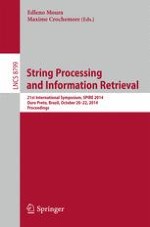This book constitutes the proceedings of the 21st International Symposium on String Processing and Information Retrieval, SPIRE 2014, held in Ouro Preto, Brazil, in October 2014. The 20 full and 6 short papers included in this volume were carefully reviewed and selected from 45 submissions. The papers focus not only on fundamental algorithms in string processing and information retrieval, but address also application areas such as computational biology, Web mining and recommender systems. They are organized in topical sections on compression, indexing, genome and related topics, sequences and strings, search, as well as on mining and recommending.
